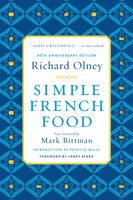Advertisement
Chopping
Appears in
Published 1974
Meats that are ground or chopped mechanically are always crushed. The fibrous structure of the flesh is broken, the succulent juices originally imprisoned within this structure escape, and therefore the forcemeat is always pastier in texture and drier than when composed of meats chopped by hand. The forcemeat, moreover, gains in character when the different meats in its composition are chopped more or less finely, lending a varied texture to the whole.
To chop meat by hand, scrape it free from all fragments of tendon, nervous tissue, or skin, cut it first into thin strips, cut the strips crosswise into tiny cubes, then chop, carefully and slowly at first, keeping the point of the knife in fulcrum-contact with the chopping block. When the meat is reduced to small enough pieces to form a cohesive mass, fragments of which will not fly in all directions, begin chopping more rapidly, using, preferably, two large “chef’s” knives of the same size and weight, one in each hand, held somewhat above the board, chopping firmly, but not violently, with alternate knives in a rhythmic, loose-wristed motion. As the chopped mass is flattened out, regularly fold it over on itself with the blade of a knife, turn it over on the board, and begin again, continuing to fold, turn over, and chop until the desired degree of fineness is achieved. If you do not have knives of the same size and weight, chop with one hand only—the rhythm is lost with unequal weights.


